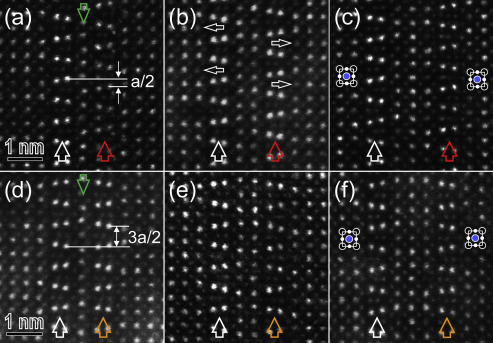Recently, A paper named "Atomic scale investigation of planar defects in 0.95Na0.5Bi0.5TiO3–0.05BaTiO3 thin films on SrTiO3 (001) substrates" is published in Journal of Alloys and Compounds (IF:2.999). Mr. Xiao-Wei Jin is the first and Prof. Shao-Bo Mi is the communications writer.
Thin films of lead-free piezoelectric 0.95Na0.5Bi0.5TiO3–0.05BaTiO3 (0.95NBT–0.05BT) are epitaxially grown on single crystalline SrTiO3 (001) substrates at 800 °C, 850 °C and 900 °C, respectively, by a high-pressure sputtering deposition technique. The microstructure of the thin films is investigated by means of aberration-corrected scanning transmission electron microscopy. Planar defects are observed and the density of the defects increases with the increase of the film-growth temperature. Two types of planar defects in the films are studied at the atomic scale. One consists of groups of edge-sharing TiO6 octahedra with Bi atoms located between the TiO6 octahedral groups, and the other exists in the form of Na/Bi(Ba)–O2–Na/Bi(Ba) layer parallel to the (010) plane of the films. Based on the structure feature of the planar defects, the propagation of the planar defects related to edge-sharing TiO6 octahedra within the films and from the film-substrate interface is discussed. Furthermore, the ordering of the planar defects is expected to form new structures. In comparison with the microstructure of 0.95NBT–0.05BT bulk materials, the appearance of the high-density planar defects observed within the films could be considered to be responsible for the difference in the physical properties between the bulk materials and the films.
Highlights:
●NBT–BT films have been successfully prepared on SrTiO3 (001) substrates.
●Complex planar defects of zigzag-like and Aurivillius-type have been determined.
●The propagation of the planar defects in the films have been characterized.
●The intergrowth of planar faults with NBT–BT structure units results in the formation of new structures.
●The NBT–BT/SrTiO3 interface structure has been determined at the atomic scale.

The work was supported by the National Basic Research Program of China (No. 2015CB654903) and the National Natural Science Foundation of China (Nos. 51471169 and 51390472).
Link:
http://www.sciencedirect.com/science/article/pii/S0925838816306892